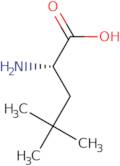β-tert-Butyl-L-alanine
CAS: 57224-50-7
Ref. 3D-FB48799
| 1g | Descatalogado | ||
| 2g | Descatalogado | ||
| 5g | Descatalogado | ||
| 10g | Descatalogado | ||
| 500mg | Descatalogado |
Información del producto
- b-tBu-L-Ala-OHL-Neopentylglycine
- (2S)-2-Amino-4,4-dimethylpentanoic acid
- 3-tert-Butyl-<span class="text-smallcaps">L</span>-alanine
- 4-Methyl-<span class="text-smallcaps">L</span>-leucine
- 4-methyl-L-leucine
- <span class="text-smallcaps">L</span>-2-Amino-4,4-dimethylpentanoic acid
- <span class="text-smallcaps">L</span>-Leucine, 4-methyl-
- <span class="text-smallcaps">L</span>-γ-Methylleucine
- H-.beta.-tBu-Ala-OH
- Pentanoic acid, 2-amino-4,4-dimethyl-, (2S)-
- Ver más sinónimos
- γ-Methyl-<span class="text-smallcaps">L</span>-leucine
- L-γ-Methylleucine
- L-Leucine, 4-methyl-
Beta-tert-butyl-L-alanine is a cyclic peptide that has opioid receptor agonist activity. It is used as a prophylactic agent for the treatment of inflammation, and is effective against amides, which are synthetic peptides. Beta-tert-butyl-L-alanine has been shown to be synthesized from the reaction of α,β-unsaturated amide with trifluoroacetic acid. The amide is synthesized by reacting an amine with propylene oxide in the presence of a strong base such as sodium hydroxide or potassium hydroxide. This reaction produces a beta amino ester of a carboxylic acid (e.g., acetic acid) and an alcohol (e.g., ethanol).





